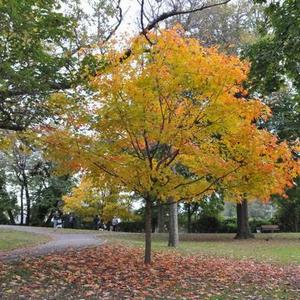
places_parks_playgrounds_300x300
Place Category: Parks and Playgrounds
This square honors World War I (1914-1918) veteran Corporal Frank Farrell Fagan. Fagan was born on January 14, 1896 in Astoria, Queens and served with distinction in France during World War I. He enlisted in the Marines in Philadelphia on May 2, 1917 and served overseas from July 3, 1917 to August 3, 1919. Fagan was assigned to the 43rd Company of the 5th Regiment, fighting in the Toulon Sector, the Aisne Defensive, the Château-Thierry Sector, the Aisne-Marne Offensive at Soissons, and the Marbache Sector of the St. Mihiel Offensive. He was discharged with excellent character on August 13, 1919. This square was named for Fagan by local law on May 3, 1932.
While serving in France, Fagan fought in a number of important battles. The Aisne Defensive in the Chateau-Thierry Sector turned the German forces back after their attack of the Champagne on May 27, 1918. The Allies again defeated the German forces, capturing the town of Soissons in the Aisne-Marne Offensive on July 15, 1918. The St. Mihiel Offensive was the first independent demonstration of American strength on the Western Front, led by Major General John Pershing on September 12, 1918. Fagan was promoted to Corporal on January 1, 1918, and received the French Croix de Guerre with a gilt star for coolness and bravery. The French Croix de Guerre was created in 1915 to award all members of the Allied Forces for acts of courage in battle.
Fagan Square, located in the northwestern Queens neighborhood of Astoria, is surrounded by several sites of historic interest. Northwest of the square on Newtown Road and 46th Street, a small cluster of 18th-century homes from the hamlet of Middletown can be found. In 1721 one of the first schools in Queens was built at the intersection of the 1652 Hallet’s Road (to Hell Gate) and the 1640 Ride Road (to Hunter’s Point) by the Hallet, Moore, Skillman and Bragaw families. British and Hessian troops marched by the school during the American Revolution (1775-1783). Around 1820, a bag containing thousands of dollars in gold coins was found in a schoolhouse wall. They had apparently been hidden there by Schoolmaster John Kearns during the Revolution and never reclaimed.
The name Middletown remained in use until a replacement was suggested in 1839 by Stephen A. Halsey. A fur merchant and land developer, Halsey petitioned the state legislature to name the area after the prominent fur trader John Jacob Astor. The residents agreed to change the name in the hopes that Astor would donate money to the village’s young ladies’ seminary (Astor eventually sent five hundred dollars). On May 4, 1870, Astoria and several other Queens neighborhoods, including Hunter’s Point, Steinway, Blissville, Dutch Kills, Bowery Bay and Ravenswood consolidated to form a single entity- Long Island City. Officials debated a name for the new union and finally agreed on Long Island City, after the newspaper that had started operation there in 1865- the Long Island City Star.
Across Broadway and south of Fagan Square, one can see examples of Mathews Model Flats. Some of the most innovative housing attempted in New York, the “flats” were simple, sturdy, and relatively cheap to construct. They are the models for the three-story six family buildings that fill the nearby neighborhoods of Ridgewood, Elmhurst, and Woodside.
Broadway, Newtown Road, and 48th Street bound Fagan Square. Parks acquired the site by condemnation on June 18, 1915. Today, the triangle boasts a lively covering of shrubs and is part of the Greenstreets program. Greenstreets is a joint project of Parks and the New York City Department of Transportation begun in 1986 and revived in 1994. Its goal is to convert paved street properties, such as triangles and malls, into green spaces.
- corporal frank park
New York
New York
United States No Records Found
Sorry, no records were found. Please adjust your search criteria and try again.
Google Map Not Loaded
Sorry, unable to load Google Maps API.
-

